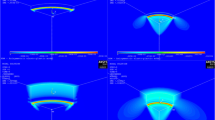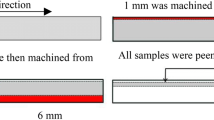Abstract
The same shot-peening treatment was applied to five steels with different mechanical properties. The induced residual stress profiles were analyzed using X-ray diffraction and incremental hole drilling (IHD). The results of both techniques showed that IHD can still be successfully used for measuring shot-peening residual stresses, even if these exceed the yield strength of the bulk material. Expected errors due to the plasticity effect are reduced by the strain hardening of the surface. For an assessment of the reliability of IHD data, strain-hardening variation was quantified by microhardness measurements to estimate the yield strength of the plastified layer. All the main calculation methods for IHD were applied. The results were compared and discussed with respect to the characteristics of each method.
Similar content being viewed by others
References
Belassel, M., Lebrun, J.L., Denis, S., Gautier, E., and Bettembourg, J.P., “Effect of Thermal and Mechanical Loading on the Generation of Macro and Micro Stresses in Eutectoid Steel,” Proceedings of the 4th International Conference on Residual Stresses, Baltimore, MD, 392–401 (1994).
Niku-Lari, A., Lu, J., andFlavenot, J.F., “Measurement of Residual Stress Distribution by the Incremental Hole-drilling Method,”J. Mech. Working Tech.,11,165–188 (1985).
Chant, M.J., Griffith, R.A., andMiles, L., “Comparison of Two Methods of Measuring Residual Stresses Arising from Surface Treatment,”J. Mech. Working Tech.,8,181–191 (1983).
Le Calvez, C., Lebrun, J.L., Cluzeau, C., and Harcouet, P., “Industrial Optimisation of Stress Gradient Determination by X-ray Diffraction and Incremental Hole-drilling on Beryllium and Aluminium Alloy,” Recent Advances in Experimental Mechanics, S. Gomes et al., eds., A. A. Balkema, Rotterdam, 751–756 (1994).
Fathallah, R., Cao, W., Castex, L., Webster, P.S., Ezeilo, A., Webster, G.A., and Webster, P.J., “Comparison of Residual Stresses Determined by X-ray Diffraction, Neutron Diffraction and the Hole Drilling Method in Aerospace Shot-peened Materials,” Proceedings of the 4th International Conference on Residual Stresses, Baltimore, MD, 834–843 (1994).
Lu, J. andFlavenot, J.F., “Applications of the Incremental Hole-drilling Method for Measurement of Residual Stress Distribution,”Exp. Techniques,13,18–24 (1989).
Baron, H.U., “Kombinierter Einsatz der Röntgenbeugung und der Bohrlochmethode bei der industriellen Eigenspannungsermittlung,” Residual Stresses, Proc. European Conference on Residual Stresses 1992, Oberursel, Deutsche Gesellschaft für Materialkunde, 269–278 (1993).
Zhu, W.X. andSmith, D.J., “Residual Stresses by Hole-drilling in Curved Components,”Recent Advances in Experimental Mechanics, S. Gomes et al., eds., A. A. Balkema, Rotterdam, 777–782 (1994).
Jo, J., Hendricks, R.W., Swanson, R.E., andFoutz, R.V., “Residual Stresses in Railroad Car Wheels,”Adv. X-ray Anal.,34,611–622 (1991).
Lu, J., Bouhelier, C., Lieurade, H.P., Baralle, D., Miege, B., andFlavenot, J.F., “Study of Residual Welding Stress Using Step-by-step Hole Drilling and X-ray Diffraction Method,”Welding in the World,33 (2),118–128 (1994).
Villard, C., Viola, A., Zeller, E., Castellucci, P., andDuchazeaubeneix, J.M., “Techniques de Mésures de Contraintes Résiduelles: Contribution à l'Étude de l'Amélioration de la Tenue en Fatigue d'Alliages Utilisés en Aéronautique,”J. de Physique IV,6,239–249 (1996).
Kornmeier, M., “Analyse von Abschreck-und Verformungseigenspannungen mittels Bohrloch-und Röntgenverfahren,” PhD thesis: Institut für Werkstofftechnik, Universität Gh Kassel (1999).
Beaney, E.M. andProcter, E., “A Critical Evaluation of the Center Hole Technique for the Measurement of Residual Stresses,”Strain,10,7–15 (1974).
Beaney, E.M., “Accurate Measurement of Residual Stress on any Steel Using the Center Hole Method,”Strain,12,99–106 (1976).
“Measurement of Residual Stresses by the Hole-drilling Strain Gage Method,” Technical Note No. TN-503-4, Vishay-Measurements Group Inc., 1–19 (1993).
Schwarz, T. andKockelmann, H., “Die Bohrlochmethode-ein für viele Anwendungsbereiche optimales Verfahren zur Experimentellen Ermittlung von Eigenspannungen,”HBM, Messtechnische Briefe,29 (2),33–38 (1993).
Nickola, W.E., “Practical Subsurface Residual Stress Evaluation by the Hole Drilling Method,” Proceedings of the SEM Spring Conference on Experimental Mechanics, New Orleans, 47–58 (1986).
Schajer, G.S., “Measurement of Non-uniform Residual Stress Using the Hole-drilling Method,”ASME J. Eng. Mat. Tech.,110 338–343,344–349 (1988).
Tabor, D., “A Simple Theory of Static and Dynamic Hardness,”Proc. Roy. Soc. Lon. A,192,247–274 (1948).
George, R.A., Dinda, S., and Kasper, A.S., “Estimating Yield Strength from Hardness Data,” Metal Prog., 30–35 (May 1976).
Cahoon, J.R., Broughton, W.H., andKutzak, A.R., “The Determination of Yield Strength from Hardness Measurements,”Metall. Trans.,2,1979–1983 (1971).
Mathar, J., “Ermittlung von Eigenspannungen durch Messung von Bohrlochverformungen,”Archiv für das Eisenhüttenwesen,6,277–281 (1933).
ASTM E837-94a, “Standard Test Method for Determining Residual Stresses by the Hole-drilling Strain-gage Method,” Annual Book of ASTM Standards, American Society for Testing and Materials, Philadelphia, 1–7 (1994).
Beghini, M., Bertini, L., andRaffaelli, P., “Numerical Analysis of Plasticity Effects in the Hole-drilling Residual Stress Measurement,”J. Test. Eval.,22,522–529 (1994).
Gibmeier, J., “Untersuchung plastischer Dehnungsanteile bei der Bohrlochmethode—FEM-Modellierung experimentell ermittelter Dehnungsverläufe,” Diplomarbeit, Institut für Werkstofftechnik, Universität Gh Kassel (1998).
Bijak-Zochowski, M., “A Semi-destructive Method of Measuring Residual Stresses,”VDI-Berichte,313,469–476 (1978).
Flaman, M.T. andManning, B.H., “Determination of Residual-stress Variation with Depth by the Hole-drilling Method,” EXPERIMENTAL MECHANICS,25,205–207 (1985).
Kelsey, R.A., “Measuring Non-uniform Residual Stresses by the Hole Drilling Method,”Proc. Soc. Exp. Stress Anal.,14,181–194 (1956).
Schajer, G.S., “Application of Finite Element Calculations to Residual Stress Measurements,”ASME J. Eng. Mat. Tech.,103,157–163 (1981).
Wern, H., “Measurement of Non-uniform Residual Stresses Using the Hole Drilling Method—A New Integral Formalism,”Strain,31 (2),63–68 (May 1995).
Kockelmann, H. andSchwarz, T., “Vergleich Praktizierter Auswerteverfahren der Bohrlochmethode,”Experimentelle Spannungsanalyse, Kolloquium Kölln 1993, GMA-Bericht,22,93–103 (1993).
Lu, J., ed., Handbook of Measurement of Residual Stresses, Society for Experimental Mechanics, Bethel, CT, 5–34, 71–131 (1996).
Flaman, M.T., Mills, B.E., andBoag, J.M., “Analysis of Stress-variation-with-depth Measurement Procedures for the Center-hole Method of Residual Stress Measurement,”Exp. Techniques,11,35–37 (1987).
Schajer, G.S. andAltus, E., “Stress Calculation Error Analysis for Incremental Hole-drilling Residual Stress Measurements,”ASME J. Eng. Mat. Tech.,118,120–126 (1996).
Macherauch, E. andMüller, P., “Das sin 2ψ-Verfahren der röntgenographischen Spannungsmessung,”Zeitschrift für angewandte Physik,13,305–312 (1961).
Flaman, M.T., “Investigation of Ultra-high Speed Drilling for Residual Stress Measurements by the Center Hole Method,” EXPERIMENTAL MECHANICS,22,26–30 (1982).
Author information
Authors and Affiliations
Rights and permissions
About this article
Cite this article
Nobre, J.P., Kornmeier, M., Dias, A.M. et al. Use of the hole-drilling method for measuring residual stresses in highly stressed shot-peened surfaces. Experimental Mechanics 40, 289–297 (2000). https://doi.org/10.1007/BF02327502
Received:
Revised:
Issue Date:
DOI: https://doi.org/10.1007/BF02327502




